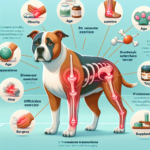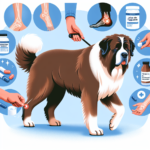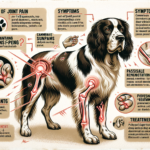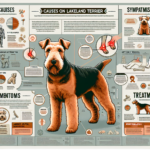Tibetan Terrier Joint Pain: Causes, Symptoms, Prevention, and Treatment
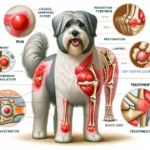
Introduction
The Tibetan Terrier, often referred to as the “Holy Dog of Tibet,” is a medium-sized breed known for its long, flowing coat and friendly disposition. Originating from the mountainous regions of Tibet, these dogs were traditionally kept as companions and watchdogs by monks in Tibetan monasteries. Despite their name, Tibetan Terriers are not true terriers but are part of the non-sporting group. They are characterized by their sturdy build, expressive eyes, and a distinctive double coat that provides protection against harsh weather conditions.
Like many breeds, Tibetan Terriers are prone to certain health issues, with joint pain being a significant concern. Joint health is crucial for maintaining the overall well-being and quality of life for these dogs. Given their active nature and the physical demands of their historical roles, ensuring optimal joint health is essential for preventing discomfort and mobility issues as they age.
Breed-Specific Joint Pain Risks
Genetic Predisposition
Tibetan Terriers have a genetic predisposition to several joint-related issues, including hip dysplasia, elbow dysplasia, and arthritis. Hip dysplasia is a condition where the hip joint does not fit properly into the hip socket, leading to pain and mobility issues. Elbow dysplasia involves abnormal development of the elbow joint, causing lameness and discomfort. Arthritis, a degenerative joint disease, can also affect Tibetan Terriers, leading to chronic pain and stiffness.
Age-Related Risks
As Tibetan Terriers age, the risk of developing joint pain increases. Typically, signs of joint issues may start to appear in middle age, around 5 to 7 years old. However, some dogs may show symptoms earlier or later, depending on their genetic makeup and lifestyle. It’s essential for owners to monitor their dogs for any signs of joint discomfort as they age and to take proactive measures to maintain joint health.
Activity Level and Joint Stress
Tibetan Terriers are known for their playful and energetic nature. While regular exercise is vital for their overall health, excessive or high-impact activities can put stress on their joints. Activities such as jumping, running on hard surfaces, or engaging in strenuous sports can exacerbate joint issues. It’s crucial to balance their activity level to ensure they remain active without overburdening their joints.
Common Symptoms of Joint Pain in Tibetan Terriers
General Symptoms
- Limping or favoring one leg
- Stiffness, especially after rest or sleep
- Reluctance to climb stairs or jump
- Decreased activity or playfulness
- Visible discomfort or pain when touched
- Swelling around the joints
Breed-Specific Symptoms
In Tibetan Terriers, joint pain may manifest as a reluctance to engage in activities they once enjoyed, such as playing fetch or going for long walks. They may also show signs of discomfort when grooming, particularly around the hip and elbow areas. Owners should be vigilant for any changes in behavior or mobility that could indicate joint pain.
When to Consult a Vet
If you notice any of the above symptoms in your Tibetan Terrier, it’s essential to consult a veterinarian promptly. Early diagnosis and intervention can significantly improve the prognosis and quality of life for your dog. Regular veterinary check-ups are also crucial for monitoring joint health and catching any issues early.
Preventive Measures for Joint Health
Exercise Recommendations
Regular, low-impact exercise is vital for maintaining joint health in Tibetan Terriers. Activities such as walking, swimming, and gentle play are excellent options. Avoid high-impact exercises like jumping or running on hard surfaces, as these can exacerbate joint stress. Aim for consistent, moderate exercise to keep your dog active and healthy without overburdening their joints.
Dietary Suggestions
A balanced diet rich in essential nutrients can support joint health. Consider incorporating foods or supplements that contain glucosamine, chondroitin, and omega-3 fatty acids, which are known to promote joint health. High-quality commercial dog foods often include these nutrients, but you can also consult your veterinarian for specific dietary recommendations tailored to your dog’s needs.
Weight Management
Maintaining a healthy weight is crucial for reducing joint stress in Tibetan Terriers. Excess weight can exacerbate joint issues and lead to increased pain and mobility problems. Monitor your dog’s weight regularly and adjust their diet and exercise routine as needed to ensure they remain within a healthy weight range.
Early Screening and Monitoring
Regular veterinary check-ups and early screening for joint issues can help catch problems before they become severe. Your veterinarian may recommend specific tests, such as X-rays or joint fluid analysis, to assess joint health. Early intervention can significantly improve outcomes and help manage joint pain effectively.
Treatment Options for Joint Pain
Non-Surgical Treatments
Non-surgical treatments for joint pain in Tibetan Terriers include medications, physical therapy, and lifestyle adjustments. Anti-inflammatory medications and pain relievers can help manage pain and reduce inflammation. Physical therapy, including exercises and massage, can improve mobility and strengthen the muscles around the joints. Lifestyle adjustments, such as providing a comfortable bed and avoiding high-impact activities, can also alleviate joint pain.
Surgical Options
In severe cases, surgical intervention may be necessary to address joint pain. Common surgical options include hip replacement, joint fusion, and arthroscopy. These procedures can significantly improve mobility and reduce pain, but they come with risks and require a thorough evaluation by a veterinary specialist. Discuss the potential benefits and risks with your veterinarian to determine the best course of action for your dog.
Alternative Therapies
Alternative therapies, such as acupuncture, hydrotherapy, and chiropractic care, can also benefit Tibetan Terriers with joint pain. Acupuncture involves inserting thin needles into specific points on the body to relieve pain and promote healing. Hydrotherapy, or water therapy, provides low-impact exercise that can improve joint mobility and reduce pain. Chiropractic care focuses on aligning the spine and joints to improve overall function and reduce discomfort.
Lifestyle and Management Tips
Daily Care Routine
A consistent daily care routine can help manage and alleviate joint pain in Tibetan Terriers. This routine may include gentle exercise, a balanced diet, and regular grooming to monitor for any signs of discomfort. Providing a comfortable, supportive bed and avoiding high-impact activities can also make a significant difference in your dog’s quality of life.
Modifying the Home Environment
Making your home more comfortable for a dog with joint pain can involve several modifications. Consider installing ramps to help your dog navigate stairs or get onto furniture without jumping. Orthopedic beds provide additional support and comfort for sore joints. Ensure that food and water bowls are at a comfortable height to reduce strain on the neck and joints.
Long-Term Management
Long-term management of joint pain involves regular veterinary check-ups, consistent exercise, and a balanced diet. Monitoring your dog’s weight and adjusting their lifestyle as needed can help manage joint pain effectively. Consider incorporating alternative therapies, such as acupuncture or hydrotherapy, into your dog’s routine to provide additional relief and improve their overall well-being.
FAQs About Tibetan Terriers and Joint Pain
What are the early signs of joint pain in Tibetan Terriers?
Early signs of joint pain in Tibetan Terriers include limping, stiffness, reluctance to move, and decreased activity levels. If you notice any of these symptoms, consult your veterinarian for a thorough evaluation.
Can joint pain in Tibetan Terriers be prevented?
While genetic predisposition cannot be changed, you can take preventive measures to reduce the risk of joint pain. These include maintaining a healthy weight, providing regular low-impact exercise, and ensuring a balanced diet rich in joint-supporting nutrients.
Are there specific exercises that are better for Tibetan Terriers with joint pain?
Yes, low-impact exercises such as walking, swimming, and gentle play are ideal for Tibetan Terriers with joint pain. Avoid high-impact activities like jumping or running on hard surfaces to prevent further joint stress.
What dietary supplements can help with joint health in Tibetan Terriers?
Supplements containing glucosamine, chondroitin, and omega-3 fatty acids can support joint health in Tibetan Terriers. Consult your veterinarian for specific recommendations based on your dog’s needs.
When should I consider surgical options for my dog’s joint pain?
Surgical options should be considered when non-surgical treatments are no longer effective, and your dog is experiencing significant pain and mobility issues. Consult your veterinarian to discuss the potential benefits and risks of surgery for your dog.
Conclusion
Joint pain is a common concern for Tibetan Terriers, but with proper care and preventive measures, you can help ensure your dog remains active and comfortable throughout their life. Regular veterinary check-ups, a balanced diet, and appropriate exercise are crucial for maintaining joint health. If you notice any signs of joint pain, consult your veterinarian promptly to explore treatment options and develop a comprehensive care plan. By taking proactive steps, you can help your Tibetan Terrier enjoy a happy, healthy life free from joint pain.

